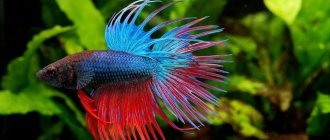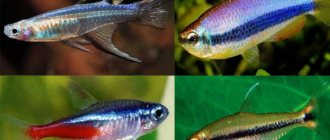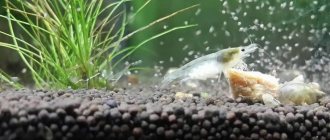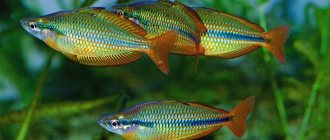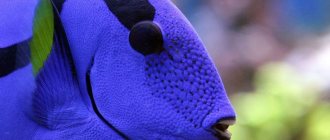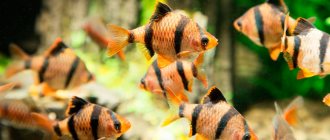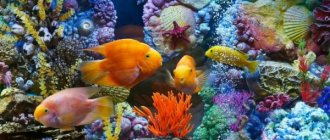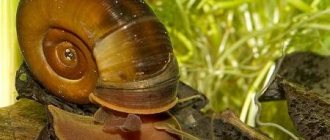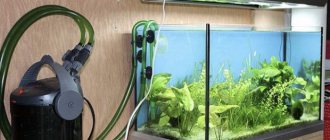Incredibly graceful, bewitching people with the smooth movements of their veiled tails, betta fish instantly attract a person’s attention. There are many varieties of these fish: from single-colored to spotted, pearlescent, also differing in the shape and size of their fins.
All kinds of colors explain their incredible popularity both among aquarium fish lovers and among professional breeders. Despite their fragile and delicate appearance, cockerels have a persistent and rebellious character!
History of discovery
At the beginning of the 19th century, the inhabitants of Siam became interested in unremarkable fish, aggressive towards their relatives. They began to be regularly used to participate in fights for money, and enterprising Siamese began to actively crossbreed wild individuals to obtain new species.
The resulting fish was named Pla Cat, which translates to “biting fish.” The most successful individuals were presented to the King of Siam, who settled them in his palace.
In 1840, the ruler presented several valuable fish to the naturalist Theodore Cantor. The Dane classified them and placed them in the genus Macropodus. But already in 1909, the famous ichthyologist Charles Tate renamed the species Betta splendens. It is possible that the genus was named in honor of the militant Bettah tribe that existed at that time, and the specific name is derived from splendid - “beautiful”, “wonderful”.
In 1910, the fish were brought to the United States. They got here thanks to the American breeder Frank Locke, who was one of the first to develop an alternative color variation of aquarium bettas. True, he mistakenly called it a new species - Betta cambodia.
The appearance of cockerels in Russia is inextricably linked with the names of two domestic aquarists - Melnikov and Desnitsky. At the beginning of the 20th century, one was the first in the country to start breeding labyrinth fish, the second brought from Singapore a whole collection of exotic inhabitants of reservoirs.
Natural enemies of rooster fish
Photo: Rooster fish
Despite the aggressive behavior of the fish, they still have quite a lot of enemies in nature. Although one can often find an emphasis on the fact that the main danger for them is humans, there are still a number of other enemies. By the way, a person also poses a danger indirectly. By draining water bodies through their activities and deteriorating the environment, humans are capable of causing serious harm to these amazing creatures.
It is extremely difficult to say exactly what enemies await rooster fish in nature. We are talking primarily about predatory fish species. For marine life, these can be exceptionally large breeds of fish. Also in the Black Sea basin, representatives of this species are not neglected by dolphins.
If we talk about freshwater bettas, even small predators can pose a danger to them. In addition, there is danger from predatory animals and birds that do not mind eating fish that may live in shallow water.
The worst thing for the fish is that it has such a garish bright color. He attracts special attention to her from her enemies; it is practically impossible for her to remain unnoticed under any circumstances. They cannot always help marine inhabitants, who have rather sharp fins - it is not difficult to catch up with them due to their excessively slow movement.
Appearance
Betta fish are not large in size and grow up to 4-5 cm in length. They have an oblong, oval, laterally compressed body and a special respiratory organ - a labyrinth. It consists of plates with a dense network of blood vessels. The labyrinth is localized in the accessory epibranchial plane and helps the fish breathe atmospheric air. The upper and caudal fins of fish are predominantly rounded. The chest most often has a pointed configuration.
In nature, betta fish are usually dark brown with rows of shiny green spots. The color of their scales may vary depending on conditions. At rest, the color of the fish pales, during the spawning period or during spawning it becomes more intense.
The difference between a male and a female cockerel
The fry of fighting fish differ after 2 months of life:
- the body of a male cockerel is 1 cm longer, with long developing fins, and the color is brighter;
- in a female cockerel, the abdomen is marked with a wide round fin and a white dot - the ovipositor;
- female cockerel does not get involved in fights, but often runs away if she does not plan to spawn;
- The male has an aggressive disposition.
When males meet, they pose in front of each other, demonstrate the brightness and size of their tail and fins, play with glitter, choosing the moment to attack.
Varieties
More than 70 breeds of betta fish are now known, the representatives of which differ in color and shape of fins. Depending on the tail configuration, they are:
- royal;
- posters;
- racemetails;
- crown-tailed;
- deltatails;
- crescent-tailed;
- round-tailed;
- flagtails;
- veil-tailed;
- two-tailed.
Depending on the color of the fish, bettas are:
- single-color (cream, white, yellow, black, red, green, orange, purple, blue);
- two-color (the body and fins are painted in different shades);
- multicolor (body of one color, fins of another with transitions between shades).
A separate breed of cockerel “dragon” has been identified. These fish have a more massive body, painted predominantly in a silver-metallic shade interspersed with other colors.
Nutrition
Bettas are predatory in nature, and in the wild they happily hunt worms. However, a cockerel in an aquarium cannot obtain its own food, so care about feeding and diet rests on the owner’s shoulders. He must study in advance what to feed the betta fish. When it comes to food, the fish are unpretentious and willingly absorb any food, but to maintain the brightness of the color and the well-being of the pet, you need to ensure that the diet is varied.
Maintenance and care
Unassuming betta fish do not require special care and are suitable for keeping in the first aquarium.
Aquarium
A spacious tank is suitable for keeping fish, the volume of which is determined at the rate of 3-4 liters per 1 individual. Although a betta can live in any shaped aquarium, it is best if it is square or rectangular. The round tank is difficult to maintain and cannot be cleaned with a scraper. And in a jar, glass or glass, the fish will have nowhere to turn around, and it may die.
The aquarium does not require a tight-fitting lid to keep a betta. The fish must be able to rise to the surface to breathe atmospheric air. Otherwise she may die. And to prevent the cockerel from accidentally jumping onto the floor, the aquarium can be covered with a soft net.
On a note. The spacious rectangular aquarium can be adapted to accommodate several males. And so that the fish do not fight among themselves, the tank must be divided by partitions made of environmentally friendly material. They must have holes made for unhindered air circulation. It is recommended to plant tall plants near the partitions that will block the view.
Water
It is better to fill an aquarium for keeping betta fish with bottled or settled tap water. In order for the inhabitants of the tank to be comfortable, the liquid in it must meet the following parameters:
- temperature – 24-26 0C;
- acidity – 6.0-7.5;
- hardness – 2-12.
Betta fish are very susceptible to phosphates and nitrates. Therefore, the water in the tank for their maintenance must be regularly checked using special drop tests and replaced weekly by 25-30% of the total volume.
Equipment
Thanks to the presence of a fish labyrinth, betta fish breathe atmospheric air. Therefore, an aquarium intended for keeping them does not need to be equipped with an aerator.
To keep the water in the tank clear, it needs filtration. But due to the fact that bettas do not like rapid currents, the filter in the aquarium for keeping fish should be low-power.
Ground and decorations
The bottom of the aquarium for keeping betta fish can be filled with purchased soil, river pebbles or gravel. The main thing is that the pebbles are smooth so that the pets do not get hurt or tear their fins.
At the bottom you can install grottoes, large stones and driftwood, which will become a shelter for fish. It is important that the decorations do not have sharp corners and are environmentally friendly. Natural corals and shells are not recommended.
Plants
To maintain the biological balance of the aquatic environment and saturate it with oxygen, plants can be planted in the aquarium. Cryptocoryne, salvinia, hornwort, anubis, arrowhead and vallisneria are excellent options for a tank intended to house betta fish.
On a note. There is an opinion that live aquarium plants quickly spoil the water in a small space. Therefore, it is better to decorate small tanks with artificial silk vegetation.
Illumination
Betta fish are not picky about light levels. But in bright light their color becomes more saturated. Therefore, it is recommended to install an aquarium for keeping betta fish in a bright room or equip it with special lamps.
What does rooster fish eat?
Photo: Rooster fish
Rooster fish belongs to the category of predators. They can consume mollusks, crustaceans, and young fish. They will also not refuse to feast on small fish (sultana). Moreover: it is not easy for the gurnard to hunt its prey. He, like any predator, gets a kind of pleasure from hunting.
As soon as he manages to overtake the victim, he makes a kind of jump in its direction, attacking with special fury. Since the gurnard belongs to the category of bottom fish, it hunts exclusively on the bottom, without rising to the surface of the water or into its middle thickness for this purpose.
By the way, the diet of small betta fish deserves special attention. They are very unpretentious in food. Under natural conditions, they may even hunt insects living near the surface of a reservoir. At home, aquarists are strongly advised not to feed them beyond the norm. They are very gluttonous and do not know moderation, so they can easily become obese or even die from excess food.
Under natural conditions, fish feed on small larvae, insects, and crustaceans. By their nature, fish are predators, but they will not refuse algae or seeds that may fall into the water. But if possible, they will not refuse not only the inhabitants of the reservoir, but also insects flying by.
Compatibility
Keeping betta fish together with representatives of other species is possible only if you have a spacious aquarium. You also need to take into account the cocky nature of pets.
Betta fish can be housed together with rainbowfish, rasboras, thorns, corydoras and viviparous platies. But goldfish, tetraodons, piranhas and large cichlids are not suitable for keeping with bettas.
Important! It is extremely undesirable to place males in the same aquarium with fish that have long veil fins or bright colors. Such individuals will inevitably become victims of attacks from quarrelsome neighbors.
Habitat of the betta fish
Asia, in particular its southeastern part, is considered the homeland of the betta fish, since it is in the stagnant and slowly flowing reservoirs of Vietnam, Indonesia, Laos, Thailand and Cambodia that one can often find nondescript “wild” representatives of this species. Bettas are found everywhere in the turbid, oxygen-poor waters of rice fields, and even in the drains of large cities. Survival in such extreme conditions becomes possible thanks to an additional respiratory organ - the “labyrinth”.
Feeding
Betta fish living in their natural environment feed on zooplankton, insects, larvae and even some types of algae. When kept in captivity, pets can be given frozen food and specialized dry food.
The following options are considered the most suitable:
- Tetra Betta LarvaSticks. Complete, easily digestible food with a high content of natural color enhancers, which make the color of the fish brighter and more intense. It comes in the form of granules that mimic insect larvae and, when used regularly, helps improve water quality.
- Tetra Betta Granules. Balanced high protein food produced in the form of floating granules. It is enriched with natural color enhancers and is valued for its high content of vitamins and nutrients that help strengthen the immune system of fish.
- Tetra Betta. The food is produced in flake form and contains krill, shrimp and natural color enhancers.
When keeping fish in an aquarium, bettas need to be fed 2-3 times a day. The amount of food should be such that the pet can eat everything in no longer than 5 minutes. Once a week, it is advisable for betta fish to have a fasting day.
Vegetation
In a reservoir with Siamese fish, you can plant live or artificial plants and algae, but experienced aquarists prefer natural greenery. It helps create balance in the tank and maintains bio-equilibrium.
If the choice falls on artificial flora, then choose soft algae made from environmentally friendly material and without sharp edges. The Siamese cockerel is a day resident, and falls asleep at night, hiding in the shade of vegetation. Knowing how betta fish sleep, experienced aquarists choose plants made of silk so that they do not injure the Betta while sleeping.
When planting living greenery, it is necessary to constantly monitor growth and development, and they should not be placed too close to each other. Green flora should not occupy more than 1/3 of the reservoir. The plants are constantly looked after, removing overgrown leaves and rotten twigs.
Features of reproduction
Betta fish mature in 3-4 months and have pronounced sexual dimorphism. Males are noticeably larger and brighter than females. They have longer fins and are much more aggressive.
For breeding, cockerels of the same breed with the same color are selected. A couple of weeks before spawning, the fish are switched to a high-protein diet. This diet promotes the maturation and softening of the eggs, which prevents them from getting stuck in the female’s genitals.
A separate tank with a volume of 20 liters or more is used as a spawning tank. It is filled with soft water, the temperature of which is raised to 28 degrees, and equipped with small shelters for the female. Several floating small-leaved plants, such as duckweed or pistia, are also placed inside. But it is not recommended to cover the bottom of the tank with soil, since its presence will prevent the male from picking up the eggs that have fallen from the nest.
First, a male is released into the spawning area so that he can build a nest of air bubbles held together with saliva. The female is introduced after her abdomen begins to increase in size. Having prepared for spawning, she swims up to the nest.
The male wraps himself around his partner and helps her squeeze out the eggs, simultaneously fertilizing them. Upon completion of the process, the female moves out of the spawning area, and the male collects the eggs in the nest and looks after them. And to make it easier for the “father” to keep an eye on the offspring, a weak light is left in the aquarium at night.
The hatched fry are fed with crushed egg yolk, live dust, cyclops or brine shrimp nauplii. The formation of the labyrinth in young individuals is completed by the age of one month. And to speed up the process, weak aeration is turned on in the aquarium and the water level is reduced to 5 cm. As soon as the cockerels begin to show aggression towards their relatives, they are transferred to solitary confinement.
How to choose
If you are planning to independently select cockerels, it is better to purchase them directly from breeders in order to be confident in the genetics of the breed. If pets are bought to observe their behavior, then a pet store is suitable.
Bettas are offered by private, chain pet stores, and online stores. If you decide to purchase pets from a manufacturer, first collect information about it and read reviews. The duration of cultivation of males is important. A novice breeder should prefer an experienced one who has been presenting his products on the market for several years.
The most unattractive specimens with poor health are offered by online retail outlets. Private stores, in order to emerge victorious in the competition, order live goods from the best manufacturers and can tell the age of the purchased pets.
Do not keep cockerels in cramped containers and do not purchase them from careless breeders!
Housing conditions play a big role when choosing cockerels. It is recommended to buy decorative fish in places where they are kept in spacious heated aquariums, and not in cramped cold vases. Pay attention to the purity of the water. If the liquid is cloudy, they postpone the purchase or go to another pet store.
Males with uncharacteristic external characteristics and behavior are rejected. Invalid:
- faded color;
- cloudy and very bulging eyes;
- uneven torn edges of fins;
- growths, bumps, areas of the body without scales, violations of the integrity of the skin;
- sunken stomach;
- insufficient activity.
The listed signs are symptoms of diseases, due to which the betta can die itself, and if quarantine is not observed, the infection can be introduced into the general aquarium.
When a person approaches, a healthy betta swims faster. Sometimes the fish get tired of the endless series of visitors and do not react properly. In any case, active males move, eat the food offered with appetite, and do not lie indifferently on the bottom.
Select specimens with a bright, eye-catching color and clean, tight-fitting scales. If the fish changes color to a paler color that is not specified by breed standards, it means that it is sick or old. Survival in another aquarium depends on the age of the Siamese betta. The younger the specimen, the faster it settles into a new place. Young fish have smaller body sizes and smaller fins.
When choosing, you can distinguish a male from a female starting from 3 months of age. They look closely at the ventral fin. In females it is wider and rounder, in males it is long and thin. Another distinctive feature of the female is the presence of an ovipositor (white tubercle) near the anus.
Sex differences in betta fish are noticeable even to a beginner.
Sex differences are noticeable in body structure (males are longer, females are stockier) and in behavior - the male is more active and aggressive.
Health and life expectancy
Under good conditions and proper care, betta fish live for about 3 years. If hygiene is not observed, they develop the following diseases:
- Fin rot. The disease, the causative agent of which is the Pseudomonas bacterium, develops when kept with infected fish or plants, as well as due to feeding contaminated food and lack of quality cleaning in the aquarium. It begins with dulling and erosion of the fins and leads to their rotting and disintegration. The disease is treated with streptocide and salt baths. It is also necessary to disinfect the aquarium, replace part of the water, and wash the vegetation and substrate.
- Costiosis. The causative agent of the disease is the flagellate parasite, brought into the aquarium by infected fish or with live food. It manifests itself as clouding of the skin and a gray spot with copious mucus secretion. Costiosis is treated with malachite green and furazolidone, as well as daily replacement of 20-30% of the total volume of water.
- Ichthyophthyriosis. Infection occurs through contact with infected fish, plants or live food. A sick individual becomes lethargic, refuses food and swims in jerks. Small white dots appear on her head, resembling semolina and spreading throughout her body. For treatment, salt baths, Bicillin 5, malachite green and Antipar are used.
- Dropsy. The pathology develops against the background of infections and due to improper feeding of the pet. A sick individual experiences apathy, loss of appetite, raised scales, bloating, redness of the abdomen and fins. Dropsy is treated with a weak solution of potassium permanganate, streptocide and Bicillin 5.
Cockerels are bright labyrinthine fish with a catchy appearance and a cocky character. They do not require complicated care and will decorate any home aquarium.
Useful tips
- Do not place a mirror in the aquarium. The male can fight with his reflection until he is completely exhausted, which sometimes even leads to his death.
- Some owners become attached to their new pets and begin to pet them and touch them too often. This cannot be done, since the scales have a protective layer of mucus. If it is damaged, the fish will become easily vulnerable to disease.
PS . This magnificent decorative fish will decorate any home interior. Watching her will bring great pleasure. Adhere to proper care , following simple recommendations and it will delight you for a long time!
Preparing for spawning
Aquarium bettas are bred without significant difficulties if the required conditions are provided for them. When preparing for spawning, it is important to prepare a special aquarium where the couple should be placed. The aquarium-seater must meet the requirements:
- Be voluminous, with a capacity of at least 40 liters of water.
- There should be a partition inside the vessel to keep the female rooster separate.
- The spawning nest must be suitable for housing eggs and fry, as well as floating vegetation.
- It should have a sponge filter and heating.
- For a comfortable stay of individuals, a water height of 15 centimeters is sufficient;
- The temperature inside the vessel should be between 27–28 degrees.
